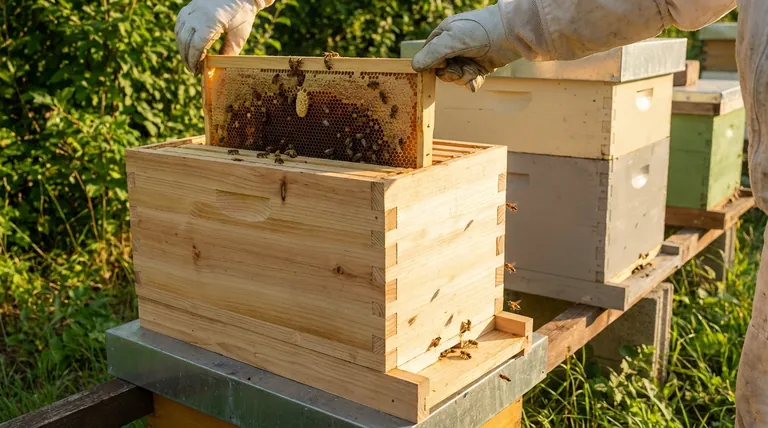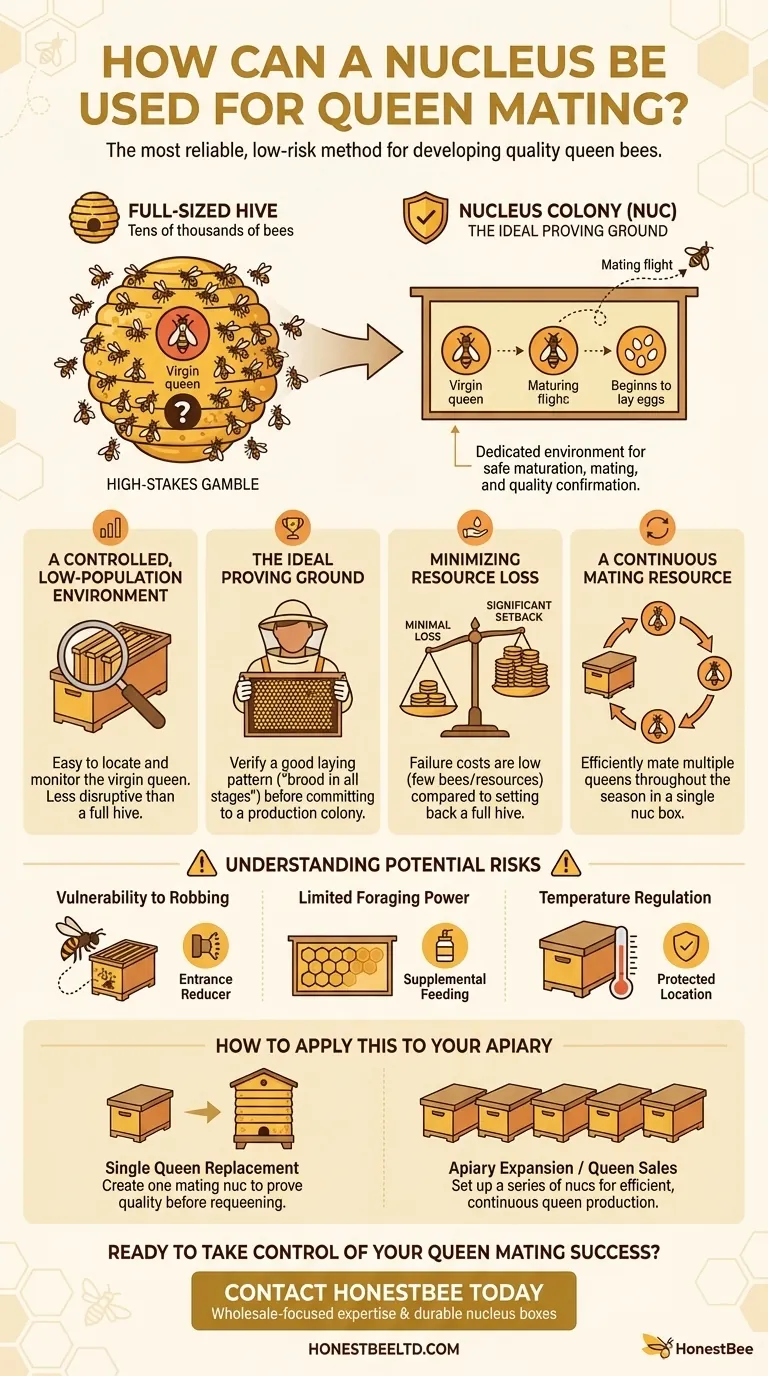The most reliable way to mate a new queen bee is by using a nucleus colony, often called a "nuc." This small, manageable hive serves as a dedicated and protected environment where a virgin queen can safely mature, take her mating flights, and begin laying eggs. Using a nuc allows you to confirm her quality and viability before risking her introduction into a full-sized, resource-intensive colony.
A nucleus hive acts as a low-risk "proving ground" for a new queen. It minimizes potential losses by using fewer bees and resources, while making it simple to observe and verify that the queen has successfully mated and is laying properly.

Why a Nuc is the Standard for Mating Queens
A full-sized beehive contains tens of thousands of bees and represents a significant investment in time and resources. Introducing an unproven virgin queen directly into that environment is a high-stakes gamble. The nucleus hive was developed as a strategic tool to mitigate this risk.
A Controlled, Low-Population Environment
A mating nuc is intentionally small, typically holding just three to five frames of bees, brood, and food.
This smaller population makes it incredibly easy to locate the new queen. Trying to find a single, unmarked virgin queen among 50,000 bees in a full hive is a difficult and disruptive task.
The Ideal Proving Ground
After a queen takes her mating flights, the most critical step is to verify her success. This isn't just about seeing eggs; it's about seeing a good laying pattern.
In a nuc, you can easily pull a frame and look for the tight, contiguous pattern of "brood in all stages" that signals a well-mated, healthy queen. This confirmation is essential before you commit her to leading a large production colony.
Minimizing Resource Loss
If a queen fails to mate, is lost on her mating flight, or proves to be a poor layer, the consequences are minimal in a nuc.
You have only lost a small population of bees and a few frames of resources. The same failure in a large colony could set back honey production for weeks and create a much more difficult situation to remedy.
A Continuous Mating Resource
A single nucleus box can be used to mate several queens sequentially throughout the season.
Once one queen is mated, proven, and moved to her permanent colony, the nuc can be given another queen cell or virgin queen to repeat the process. This makes it a highly efficient tool for beekeepers raising multiple queens.
Understanding the Potential Risks
While using a mating nuc is the preferred method, it is not without its challenges. Understanding these allows you to manage them effectively.
Vulnerability to Robbing
A nuc has a small population and, therefore, a weaker defense force. It can be a target for robbing by stronger, nearby colonies. Using an entrance reducer is critical to help the small colony defend itself.
Limited Foraging Power
The small number of foragers means a mating nuc can struggle to bring in enough nectar and pollen to be self-sufficient. You must be prepared to provide supplemental feeding, especially if there is no strong nectar flow.
Temperature Regulation
Fewer bees mean more difficulty maintaining the ideal temperature and humidity for developing brood, particularly during cool nights or weather swings. Placing the nuc in a sunny, protected location can help.
How to Apply This to Your Apiary
Your approach to using a mating nuc depends entirely on your beekeeping goals.
- If your primary focus is replacing a single queen with minimal risk: Create one mating nuc to prove your new queen's quality before you requeen your main hive.
- If your primary focus is expanding your apiary or raising queens for sale: Set up a series of mating nucs to create an efficient, continuous cycle of queen production.
Using a nucleus hive for queen mating gives you ultimate control over the success and genetic quality of your colonies.
Summary Table:
| Advantage | Key Benefit |
|---|---|
| Controlled Environment | Easy to locate and monitor the virgin queen in a small population. |
| Proving Ground | Verify a good laying pattern before committing to a full-sized hive. |
| Minimized Resource Loss | Protects your investment if a queen fails to mate or is a poor layer. |
| Continuous Mating Resource | Efficiently mate multiple queens sequentially throughout the season. |
| Strategic Apiary Management | Ideal for both single queen replacement and large-scale queen production. |
Ready to take control of your queen mating success?
As a commercial beekeeper or distributor, the quality of your queens directly impacts your productivity and profitability. HONESTBEE supplies the durable, high-quality nucleus boxes and beekeeping equipment you need to implement this reliable mating method at scale.
Let our wholesale-focused expertise help you build a more resilient and efficient apiary. Contact HONESTBEE today to discuss your equipment needs and boost your queen-rearing program!
Visual Guide

Related Products
- 5 Frame Wooden Nuc Box for Beekeeping
- HONESTBEE Professional Long Handled Hive Tool with Precision Cutting Blade
- HONESTBEE Professional Multi-Functional Hive Tool with Ergonomic Wood Handle
- HONESTBEE Advanced Ergonomic Stainless Steel Hive Tool for Beekeeping
- Professional Dual-End Stainless Steel Hive Tool for Beekeeping
People Also Ask
- What is the purpose of having a nuc in beekeeping? Build a Resilient & Productive Apiary
- How should the nuc be installed in the apiary? Ensure Colony Success from Day One
- What is a common feature of many 5-frame nuc boxes? The Integrated Feeder for Efficient Colony Growth
- What frames should be moved into the queenless hive when requeening with a nuc? Ensure a Successful Queen Introduction
- What is the most common type of standard nuc? The 5-Frame Nuc Explained



















